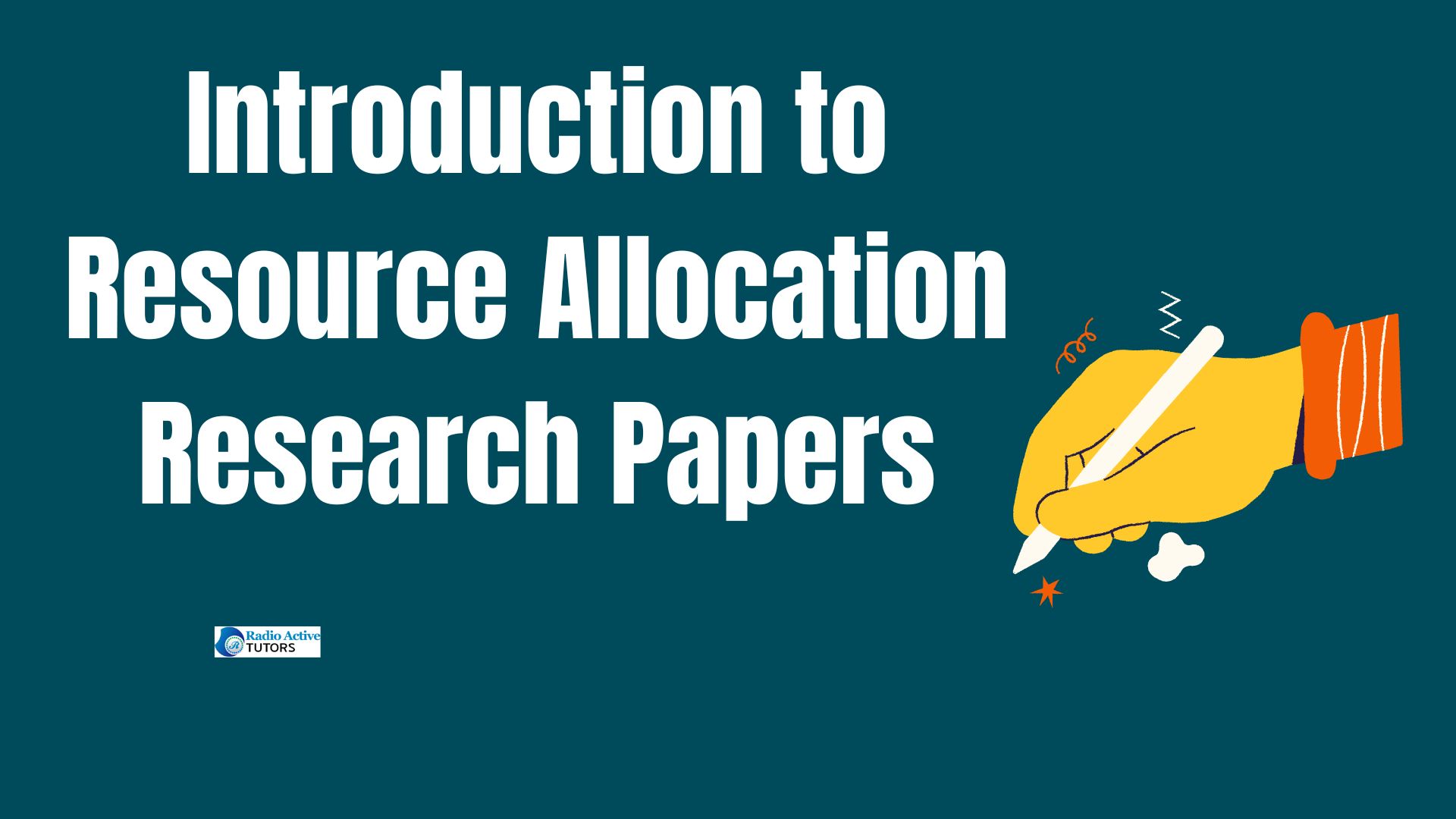Table of Contents
I. Introduction to Resource Allocation Research Papers
II. Types of Resources in Resource Allocation Research Papers
III. Theoretical Frameworks in Resource Allocation Research Papers
IV. Methodologies in Resource Allocation Research Papers
V. Practical Applications of Resource Allocation Research Papers
VI. Measuring Success in Resource Allocation Research Papers
VII. Frequently Asked Questions in Resource Allocation Research Papers
I. Introduction to Resource Allocation Research Papers

a. Definition and Importance of Resource Allocation Research Papers
Resource allocation research papers play a crucial role in the study and application of efficient resource management. These papers are meticulously crafted to explore the strategies, methodologies, and tools used to allocate resources effectively across various domains, including economics, healthcare, education, and technology. By delving into the principles of resource allocation, these research papers aim to optimize the distribution and utilization of limited resources to achieve desired outcomes.
The importance of resource allocation research papers lies in their ability to provide evidence-based insights and solutions that address the complexities of resource management. They offer a comprehensive understanding of how resources can be allocated to maximize efficiency, equity, and sustainability, thereby informing policy decisions and practical applications in both public and private sectors.
b. Historical Perspective on Resource Allocation Research Papers
The study of resource allocation has a rich historical backdrop that significantly informs contemporary research papers on the subject. Historically, resource allocation emerged as a critical concern during periods of scarcity and economic upheaval, such as the Great Depression and World Wars, where efficient distribution of resources was paramount for survival and recovery. Over time, the field has evolved, incorporating advances in economics, operations research, and decision sciences.
Pioneering work by economists like Adam Smith and later contributions by scholars such as Kenneth Arrow and Leonid Hurwicz, who explored market mechanisms and optimal allocation theories, laid the groundwork for modern research. Today, historical perspectives in resource allocation research papers provide valuable context, tracing the evolution of theories and practices that shape current methodologies. By examining past successes and failures, these papers offer lessons that enhance our understanding of resource distribution, ensuring more informed and effective strategies in addressing contemporary challenges.
II. Types of Resources in Resource Allocation Research Papers
a. Human Resources
In the context of resource allocation research papers, human resources represent a critical type of resource that encompasses the skills, expertise, and labor provided by individuals within an organization or system. Effective allocation of human resources is essential for optimizing productivity, enhancing performance, and achieving organizational goals. Research papers on this topic delve into various aspects such as workforce planning, talent management, training and development, and employee motivation. They explore methodologies for aligning human resources with strategic objectives, ensuring that the right people are in the right roles at the right time.
Moreover, these papers examine challenges such as skill mismatches, labor shortages, and the impact of technological advancements on workforce dynamics. By analyzing these factors, resource allocation research papers provide insights and recommendations for maximizing the potential of human resources, thereby contributing to the overall efficiency and success of organizations across different sectors.
b. Financial Resources

Financial resources are a fundamental category explored in resource allocation research papers, as they encompass the monetary assets required for the operation and growth of organizations and systems. Efficient allocation of financial resources is vital for achieving economic stability, fostering innovation, and supporting sustainable development. Research papers on this topic investigate strategies for budgeting, investment, and cost management to ensure optimal use of financial assets.
They address critical issues such as capital allocation, risk management, and the impact of financial constraints on project outcomes. By employing quantitative models and analytical tools, these papers provide insights into how financial resources can be allocated to maximize returns, minimize waste, and achieve long-term financial health. Additionally, they often explore the interplay between financial resources and other types of resources, offering a holistic approach to resource allocation that supports comprehensive decision-making processes in both public and private sectors.
c. Technological Resources
Technological resources represent a critical component in resource allocation research papers, encompassing the tools, equipment, and infrastructure necessary for technological advancements and innovation. These resources play a pivotal role in driving productivity, efficiency, and competitive advantage across various industries and sectors. Research papers on technological resources delve into areas such as research and development (R&D), technological infrastructure investments, and digital transformation strategies.
They explore how organizations can allocate resources effectively to adopt and leverage emerging technologies like artificial intelligence, blockchain, and Internet of Things (IoT) to enhance operational capabilities and achieve strategic objectives. Moreover, these papers often examine challenges such as technological obsolescence, cybersecurity risks, and the ethical implications of technology deployment. By offering insights and best practices, resource allocation research papers on technological resources contribute to shaping policies and practices that promote sustainable technological innovation and growth.
d. Natural Resources
Natural resources are a crucial focus in resource allocation research papers, encompassing the Earth’s renewable and non-renewable assets that contribute to economic, environmental, and social well-being. These resources include minerals, water, forests, land, and biodiversity, among others, which are essential for human survival and development. Research papers on natural resources explore sustainable management practices, conservation efforts, and the economic implications of resource extraction and utilization.
They address challenges such as resource depletion, environmental degradation, and the equitable distribution of benefits derived from natural resources. By examining strategies for efficient allocation and utilization, these papers aim to promote responsible stewardship of natural resources while balancing socio-economic development with environmental preservation. Additionally, they often advocate for policies and practices that support biodiversity conservation, climate resilience, and the protection of ecosystems for future generations.
e. Time as a Resource
Time is a fundamental resource explored in resource allocation research papers, crucial for achieving efficiency, productivity, and successful project outcomes across various domains. Research papers on time as a resource delve into methodologies and strategies for effective time management, scheduling, and prioritization of tasks and activities. They explore how time allocation impacts project planning, execution, and completion, emphasizing the importance of minimizing delays and optimizing timelines.
These papers often employ techniques such as project scheduling models, critical path analysis, and time-budgeting frameworks to enhance resource allocation decisions. Moreover, they address challenges such as time constraints, resource conflicts, and the impact of time variability on project performance. By offering insights into time as a valuable and limited resource, these research papers contribute to enhancing organizational efficiency, meeting deadlines, and achieving strategic objectives in both private and public sectors.
III. Theoretical Frameworks in Resource Allocation Research Papers
a. Classical Theories
Classical theories form a foundational aspect of the theoretical frameworks explored in resource allocation research papers, offering fundamental principles and models that shape understanding and practice in the field. These theories often draw from disciplines such as economics, operations research, and decision sciences to elucidate optimal resource allocation strategies. Key classical theories include Adam Smith’s concept of the invisible hand, which posits that market forces naturally allocate resources efficiently through supply and demand mechanisms.
Additionally, theories from scholars like Kenneth Arrow and Leonid Hurwicz have expanded on market mechanisms and social choice theory, providing frameworks for understanding resource allocation under conditions of uncertainty and imperfect information. Classical theories in resource allocation research papers serve to inform contemporary debates and practices, offering historical context and theoretical rigor that underpin discussions on efficiency, equity, and sustainability in resource management.
b. Modern Theories
Modern theories represent a dynamic evolution in theoretical frameworks within resource allocation research papers, integrating interdisciplinary insights and contemporary challenges. These theories expand upon classical foundations to address complex issues such as globalization, technological advancements, and sustainability. For instance, modern portfolio theory, developed by Harry Markowitz, applies mathematical models to optimize investment portfolios based on risk and return considerations, influencing financial resource allocation strategies.
Behavioral economics, pioneered by researchers like Daniel Kahneman and Richard Thaler, introduces psychological factors into decision-making processes, offering insights into how human behavior influences resource allocation outcomes. Moreover, game theory, advanced by scholars such as John Nash and John von Neumann, provides frameworks for analyzing strategic interactions and optimizing resource allocation in competitive environments. By synthesizing diverse perspectives and methodologies, modern theories in resource allocation research papers contribute to innovative approaches that address contemporary challenges and enhance decision-making across sectors.
c. Comparative Analysis of Different Frameworks

A comparative analysis of different frameworks within theoretical frameworks in resource allocation research papers offers valuable insights into the strengths, limitations, and applicability of various approaches to resource management. Research papers in this area systematically evaluate and contrast theoretical models such as market-based mechanisms, optimization techniques, and decision-making theories to identify their respective advantages and contexts of effectiveness.
For example, comparative studies may juxtapose classical theories like Adam Smith’s invisible hand with modern portfolio theory or behavioral economics, examining how each framework addresses different aspects of resource allocation efficiency, equity considerations, and sustainability. Such analyses not only highlight the theoretical underpinnings but also provide empirical evidence and case studies analysis to illustrate practical implications and outcomes in diverse organizational and societal contexts. By synthesizing these comparisons, resource allocation research papers contribute to advancing knowledge and guiding policymakers and practitioners in making informed decisions to optimize resource allocation strategies effectively.
IV. Methodologies in Resource Allocation Research Papers
a. Qualitative Methods in Resource Allocation Research Papers
Qualitative methods play a crucial role in methodologies within resource allocation research papers, offering in-depth insights into the complexities and nuances of decision-making processes and stakeholder perspectives. These methods encompass a variety of approaches such as case studies, interviews, focus groups, and ethnographic research, which allow researchers to explore subjective experiences, motivations, and contextual factors influencing resource allocation practices. Research papers employing qualitative methods often seek to understand the social, cultural, and political dimensions that shape resource allocation decisions, particularly in sectors like healthcare, education, and public policy.
By emphasizing qualitative data collection and analysis, these papers provide rich narratives and detailed accounts that complement quantitative approaches, offering a holistic understanding of how resources are allocated, utilized, and perceived within organizational and societal frameworks. Moreover, qualitative methodologies contribute to fostering stakeholder engagement and enhancing the relevance and applicability of research findings in addressing real-world challenges and informing policy and practice decisions.
b. Quantitative Methods in Resource Allocation Research Papers
Quantitative methods constitute a fundamental component of methodologies employed in resource allocation research papers, emphasizing rigorous analysis and numerical data to inform decision-making processes. These methods encompass statistical analysis, mathematical modeling, econometric techniques, and simulation approaches to quantify resource allocation patterns, predict outcomes, and optimize resource utilization.
Research papers utilizing quantitative methods often employ data-driven approaches to assess efficiency, effectiveness, and equity in resource allocation across various sectors such as finance, healthcare, and environmental management. They provide empirical evidence and statistical validation to support hypotheses, test theories, and evaluate the impact of different allocation strategies. By leveraging quantitative methodologies, these papers contribute to advancing evidence-based practices and policy recommendations, enabling stakeholders to make informed decisions that enhance organizational performance, optimize resource allocation, and achieve strategic objectives efficiently.
c. Mixed Methods Approaches in Resource Allocation Research Papers
Mixed methods approaches are increasingly utilized in methodologies within resource allocation research papers, integrating both qualitative and quantitative techniques to provide comprehensive insights and robust analyses. These approaches combine the strengths of qualitative methods, such as depth of understanding and contextual richness, with the rigor and generalizability of quantitative methods. Research papers employing mixed methods often begin with qualitative exploration to uncover nuanced perspectives, explore complex dynamics, and identify key themes.
Subsequently, quantitative data collection and analysis are employed to validate findings, test hypotheses, and quantify relationships across larger samples or broader contexts. By triangulating data from multiple sources, mixed methods approaches in resource allocation research papers offer a more holistic understanding of resource allocation practices, addressing both the intricacies of decision-making processes and the broader impacts on stakeholders and outcomes. This integrated approach enhances the reliability and validity of research findings, providing actionable insights that inform policy development, organizational strategies, and practical interventions across diverse sectors.
d. Case Studies and Field Research in Resource Allocation Research Papers

Case studies and field research methodologies are pivotal in resource allocation research papers, offering detailed examinations of real-world scenarios and practical applications of resource management strategies. These methodologies involve in-depth investigations of specific cases, organizations, or communities to analyze how resources are allocated, utilized, and managed in diverse contexts. Case studies provide rich qualitative data through detailed descriptions, interviews, and document analysis, offering insights into decision-making processes, challenges faced, and outcomes achieved.
Field research complements case studies by directly observing and documenting resource allocation practices in situ, often incorporating participant observation and data collection in natural settings. Together, these methodologies generate comprehensive empirical evidence that illuminates the complexities and nuances of resource allocation dynamics across sectors such as business, healthcare, education, and public policy. By focusing on real-world examples and contexts, case studies and field research methodologies contribute to advancing practical knowledge, informing best practices, and guiding decision-makers in optimizing resource allocation strategies to achieve desired organizational and societal outcomes efficiently.
V. Practical Applications of Resource Allocation Research Papers
a. Project Management in Resource Allocation Research Papers
Project management serves as a crucial domain for practical applications of resource allocation research, offering methodologies and frameworks to effectively plan, execute, and monitor projects while optimizing resource utilization. Research papers in this area explore how project managers allocate human, financial, time, and technological resources to achieve project objectives within constraints such as budget limitations and time constraints. They often delve into topics such as resource leveling, critical path analysis, risk management, and stakeholder engagement strategies to ensure efficient allocation and alignment of resources with project goals.
Practical applications of resource allocation research in project management emphasize the importance of balancing competing demands and adapting strategies to changing project dynamics, thereby enhancing project success rates, minimizing costs, and maximizing value delivery. By integrating theoretical insights with practical strategies, these research papers contribute to advancing project management practices and fostering organizational effectiveness across various industries and sectors.
b. Strategic Planning in Resource Allocation Research Papers
Strategic planning represents a critical practical application area within resource allocation research papers, focusing on the systematic process of defining organizational goals and developing strategies to allocate resources effectively to achieve those goals. Research in this domain examines how strategic planners analyze internal capabilities, external opportunities, and potential risks to make informed decisions about resource allocation across different functions and initiatives.
These papers explore methodologies such as SWOT analysis, scenario planning, and resource-based view frameworks to align resources—whether financial, human, technological, or natural—with strategic priorities. By emphasizing long-term sustainability, competitive advantage, and organizational resilience, strategic planning informed by resource allocation research helps organizations navigate uncertainties, capitalize on opportunities, and optimize resource allocation to achieve desired outcomes efficiently. Moreover, these papers contribute to enhancing strategic decision-making processes, guiding leaders in allocating resources judiciously to foster growth, innovation, and organizational success in dynamic and competitive environments.
c. Operations Management in Resource Allocation Research Papers

Operations management plays a pivotal role in the practical applications of resource allocation research, focusing on the efficient design, planning, and control of processes and systems to maximize productivity and minimize costs. Research papers in this field explore how operations managers allocate resources—including human, financial, technological, and logistical—to optimize production and service delivery. They delve into methodologies such as lean manufacturing, Six Sigma, and supply chain management to streamline operations, improve efficiency, and enhance customer satisfaction.
Practical applications of resource allocation research in operations management often involve optimizing inventory levels, scheduling production activities, managing quality control processes, and balancing capacity utilization. By leveraging empirical data and quantitative analysis, these papers provide insights into effective resource allocation strategies that reduce waste, increase throughput, and strengthen competitiveness across various industries. Ultimately, operations management informed by resource allocation research contributes to enhancing organizational performance, agility, and profitability in dynamic business environments.
VI. Measuring Success in Resource Allocation Research Papers
a. Key Performance Indicators in Resource Allocation Research Papers
Key Performance Indicators (KPIs) serve as critical metrics in measuring the success and effectiveness of resource allocation strategies within resource allocation research papers. These indicators provide quantifiable measures that evaluate how well resources—whether financial, human, time-related, or technological—are utilized to achieve organizational objectives and desired outcomes. Research papers in this area explore various KPIs tailored to specific contexts and goals, such as return on investment (ROI), cost efficiency ratios, productivity metrics, customer satisfaction scores, and sustainability performance indicators.
By analyzing KPIs, researchers can assess the efficiency, effectiveness, and impact of resource allocation decisions, identifying strengths, weaknesses, and areas for improvement. Moreover, KPIs facilitate benchmarking against industry standards and best practices, guiding decision-makers in optimizing resource allocation strategies to enhance organizational performance, strategic alignment, and overall success. Through empirical analysis and data-driven insights, resource allocation research papers underscore the importance of using KPIs to inform evidence-based decision-making and drive continuous improvement in resource management practices across diverse sectors and organizational settings.
b. Impact Assessments in Resource Allocation Research Papers
Impact assessments play a crucial role in measuring the success and effectiveness of resource allocation strategies within resource allocation research papers. These assessments systematically evaluate the outcomes, consequences, and broader impacts resulting from resource allocation decisions across various domains and sectors. Research papers in this field employ impact assessment methodologies to analyze the economic, social, environmental, and organizational effects of resource allocation practices.
They often utilize quantitative and qualitative data to assess outcomes such as cost savings, efficiency gains, stakeholder satisfaction, environmental sustainability, and long-term viability. Impact assessments help researchers and decision-makers understand the ripple effects of resource allocation decisions, identify unintended consequences, and optimize strategies to maximize positive outcomes and mitigate risks. By providing evidence of impacts, these assessments inform strategic planning, policy development, and resource allocation practices, fostering accountability, transparency, and continuous improvement in organizational performance and societal outcomes.
c. Continuous Improvement Processes in Resource Allocation Research Papers
Continuous improvement processes are integral to measuring success in resource allocation within resource allocation research papers, emphasizing iterative refinement and optimization of resource management strategies over time. These processes involve systematic review, analysis, and adjustment of resource allocation practices based on ongoing evaluation of performance metrics, stakeholder feedback, and changing external conditions. Research papers in this area highlight methodologies such as Lean Six Sigma, Kaizen, and quality management principles to foster a culture of continuous improvement in resource allocation.
By promoting transparency, collaboration, and innovation, continuous improvement processes enable organizations to identify inefficiencies, streamline operations, and enhance resource utilization efficiency. Moreover, these papers emphasize the importance of learning from successes and failures, adapting to evolving challenges, and leveraging new technologies and methodologies to achieve higher levels of effectiveness and sustainability in resource allocation practices. Through empirical research and practical insights, continuous improvement processes contribute to enhancing organizational agility, resilience, and long-term success in dynamic and competitive environments.
VII. Frequently Asked Questions
a. What is Resource Allocation Research Papers and why is it important?
b. How do different sectors approach Resource Allocation Research Papers?
c. What are the main challenges in Resource Allocation Research Papers?
d. How can technology improve Resource Allocation Research Papers?
e. What are the ethical considerations in Resource Allocation Research Papers?
f. What is the importance of Resource Allocation Research Papers?
g. How do I choose the right methodology for Resource Allocation Research Papers?
h. What are the common pitfalls in writing Resource Allocation Research Papers?
i. How can I ensure the ethical integrity of Resource Allocation Research Papers?
j. What resources are most critical to study in Resource Allocation Research Papers?
